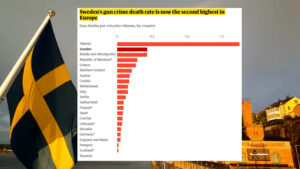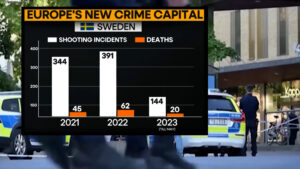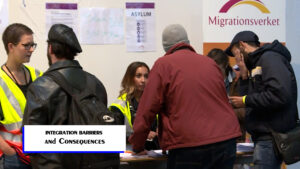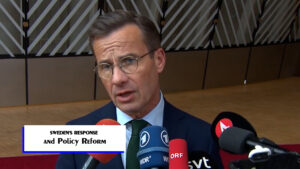INTRODUCTION
Sweden, nestled in Scandinavia, finds itself amidst a crisis that shakes its societal foundation—a tumultuous landscape marked by violent clashes, gang strife, and a startling surge in gun-related incidents. Once hailed as a paragon of safety, Sweden now grapples with the ignoble distinction of being Europe’s second-highest in gun violence, overshadowing its former reputation. Join us as we unravel the narrative of Sweden’s transformation, exploring the complex interplay of immigration and societal upheaval.
Embark on a journey through our video, “Immigration Dilemma: Sweden’s Descent,” as we depict Sweden’s evolution from a beacon of social democracy to a nation facing unprecedented levels of violence and unrest. Delve into the intricate web of challenges as Sweden confronts its immigration dilemma head-on, navigating through uncharted territory to find a path forward.

Sweden’s Immigration Quandary: Unveiling the Impact of Multiculturalism
At the crux of Sweden’s immigration dilemma lies its historically liberal asylum policies and robust welfare system, which have attracted migrants seeking refuge and opportunity. However, the influx of newcomers, particularly since the 2000s and peaking in 2015, has strained resources and tested integration efforts.
From being renowned for its prosperity and tranquillity, Sweden now grapples with soaring rates of gun-related deaths, and declining healthcare, and educational standards. The surge in violence has prompted unprecedented measures, including contemplation of deploying armed forces—a stark departure from Swedish history.
A significant driver behind this surge in violence is attributed to gang turf wars and personal vendettas, with many youths from immigrant backgrounds being recruited. The rise of multiculturalism in Swedish politics has transformed the demographic landscape, posing integration challenges.

The transition from attracting workers to welcoming refugees from diverse cultures has strained resources and led to long-term dependency on state assistance. Marginalized immigrant communities have become hotspots for criminal activity, exacerbating crime rates.
The economic toll of mass immigration has been substantial, with a decrease in GDP per capita and increased unemployment. Despite recent efforts to tighten borders, Sweden grapples with the enduring consequences of decades-long inclusive policies.

Integration Barriers and Consequences
High unemployment, language barriers, and residential segregation hinder integration efforts, leaving many immigrants marginalized. Failed integration exacerbates social divisions and poses threats to public safety.

Sweden’s Response and Policy Reform
In response, Sweden is undergoing policy reform, pivoting towards economic liberalism and tighter immigration controls. The electoral surge in right-wing parties signals a shift in immigration discourse, with discussions centered on national interests and security.

Navigating the Future: Sweden’s Task
As Sweden charts its course forward, it confronts the formidable task of balancing humanitarian values with safeguarding national interests and security. Through fostering constructive dialogue, promoting integration, and enacting effective policy measures, Sweden has the potential to navigate through this challenging period and emerge stronger and more resilient than ever before. The road ahead may be fraught with challenges, but Sweden’s resilience, innovation, and commitment to social justice offer hope for a brighter future built on the principles of inclusivity, equality, and solidarity.
If you’d like, you can watch the accompanying video, “Immigration Dilemma: Sweden’s Descent,” for a deeper exploration of Sweden’s challenges and complexities: (https://youtu.be/dIb7WY9mFwM)
